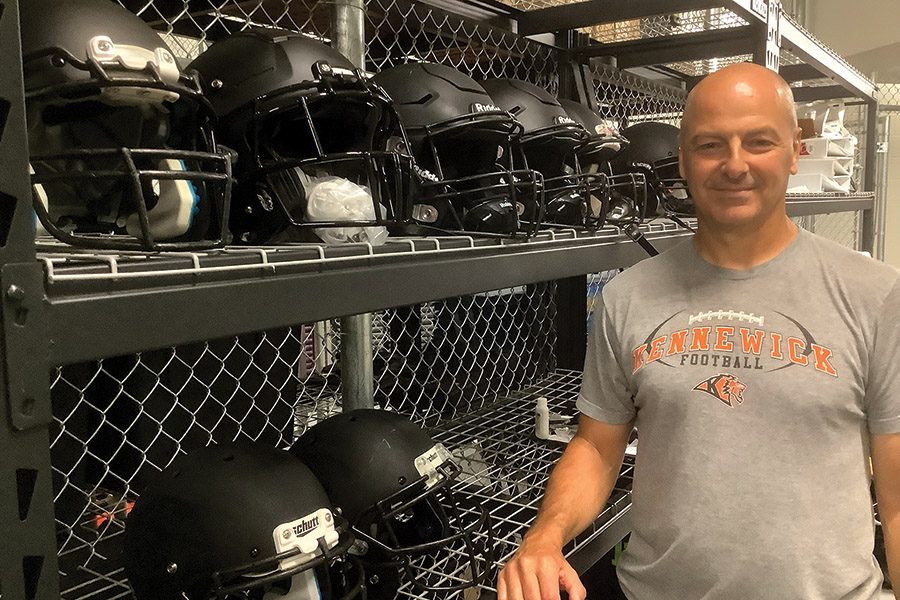
Home » Tech innovations improve high school athletics, from football helmets to stadium lighting
Tech innovations improve high school athletics, from football helmets to stadium lighting

July 13, 2022
Science and technology have made many things better when it comes to sports.
And they will continue to do so in the future.
The Tri-Cities Area Journal of Business talked to some Tri-City area high school athletic directors and one football coach about what science and technology have done for sports.
Here is what they had to say:
Football helmets
Over the past decade, scientists have found a number of former professional and college football players have suffered from chronic traumatic encephalopathy (CTE), a degenerative brain disease, after cumulative helmet hits.
That has led to changes in rules of helmet-to-helmet hits, or leading with a helmet, that has been instituted from the professional ranks all the way down to youth football.
In football, helmets are the most important piece of equipment.
As late as the 1970s, high school football players wore helmets with suspension headgear inside. That didn’t prevent a player’s head from hitting the top inside of the helmet and getting injured.
Soon, foam was added. But the technology continues to improve with materials that fit tight around a player’s head to give protection.
Today’s helmets are vastly improved from what players wore 10 years ago.
“We know that multiple brands fit differently,” said Anna Harris, Kennewick High School athletic director. “Schutt and Riddell are the best helmets we can get.”
Those brands grade high with what is called the Virginia Tech test, in which helmets are hit at every angle and graded at a 3, 4 or 5 (5 being the highest) in safety.
Most Tri-City schools purchase 12 to 14 new helmets every year, mixing up the Schutt and Riddell brands because they can fit a player differently. A comparable number are tossed out because they’re not safe anymore. Helmets typically last eight to 10 years.
With better materials in the helmets, the prices have gone up.
“Helmet prices have gone from $200 to $500 over the last 10 years,” Harris said. “All equipment has gotten expensive, just like everything else. One Baden volleyball costs $75 now. So, it’s not just football equipment.”
The largest Tri-City area high schools have anywhere from 130 to 200 athletes turn out for football every year. So, the prices can add up.
Mike Edwards, Richland High School’s athletic director, said that the state rules in high school football require football teams send off all used football helmets, after the season is over, to a company that reconditions the helmets. That must happen every two years.
“But we’re fortunate in that our high school does it every year,” Edwards said.
Larry Usher, the athletic director at Hermiston High School (as well as the athletic director responsible for the two local middle schools), said Hermiston goes a different way.
“If you buy helmets, they have to be recertified every two years,” Usher said. “By leasing helmets every year, they get recertified, get new face masks and are ready to go. It ends up costing us more. But the coaching staff felt it was better to do that, especially with the safety part of it.”
Concussion protocol
Before the season begins, in any high school sport, athletes are given cognitive tests, so that teams have a baseline of each athlete.
If an athlete takes a hard hit, trainers can test them neurologically and cognitively right then and there.
Randy Affholter is the Kennewick High School head football coach. He’s led the Lions to the Class 3A state semifinals in 2019, and the state finals in 2021.
Like most coaches, Affholter doesn’t mess with a player’s health.
“If something happens during a game or practice, they are tested to see where they are at compared to their original baseline test,” Affholter said. “We have a trainer who does the testing. But if there is any doubt, we set them down on the bench. Kids are competitive, and they’ll try to get back into the game. But if there is any question, we set them down.”
Usher said the Hermiston athletic booster club bought soft shells to put on the outside of the football players’ helmets when it seemed too many concussions were happening in practices.
It helped. But coaching is still the most important part of it all.
“The safety measures being taught right now, like tackling with your head up, really helps,” said Usher. “Obviously, the most important thing is student safety.”
Online video
In the old days, high school football coaches had a big chore the morning after Friday night games. They would drive to meet the coach of the next week’s opponent to swap game film.
For local coaches, that meant spending Saturday mornings driving to meet-up spots such as rest stops near Mattawa and restaurants in Yakima.
But a few years back, a company called Hudl put the process online with a program that can be accessed with an email address and a Hudl account.
Now no one has to travel on Saturday mornings.
“My wife is a pretty happy person with that,” Affholter said.
Schools can subscribe to different levels of Hudl, with the most basic being the film itself.
During the pandemic, when most fans weren’t allowed in gyms or stadiums, schools live-streamed games.
Harris said Kennewick High has a package where coaches can pull video right off the livestream, during a contest, and show their athletes a play or two of what’s happening in the game.
“And it’s for almost all sports,” she said.
Hudl is one of the biggest things to Affholter when it comes to technology.
In his first season at Kennewick, his offensive and defensive lines platooned – meaning no lineman played on both sides of the line. They were either on the offense or the defense.
So, with a big television monitor on the Lions’ sideline, his coaches could bring up videos of the plays the athletes had just participated in to review what had gone right or wrong.
“A lot of our assistant coaches will also make cut-ups of the last game,” he said. That means they can put together clips of the game that just involve a certain athlete – or maybe something of the opponent that athlete will face the next week.
“The kids always have email accounts,” Affholter said. “The coaches then give them the cutups and the kids can watch the film on their own down time. I think that’s one of the biggest positives of technology.”
A coach can track the amount of time a player is spending studying that film. So, there are no shortcuts.
Timing systems
Keeping track of how fast athletes run has gotten more digital.
The Kennewick, Pasco and Richland school districts each have a new timing system, which their schools share.
“You don’t see 10 stopwatches at a finish line anymore in track,” said Richland’s Edwards.
It provides more accurate times, which eventually gives college recruiters a better idea what a kid can do.
Phone apps
For athletic directors such as Harris and Edwards – who spend a huge amount of time at school sports events – technology has made their lives easier.
Harris manages the Lampson Stadium lights from an app on her phone, ensuring they’re on or off as needed. The same app controls the gym lights too.
Every Monday morning, she can look at what her home sports events are for the coming week and schedule those things from her phone.
Richland’s Fran Rish Stadium is getting a major remodel, which will give Edwards the same ability to control lighting and adjust it for the different activities that take place there.
“I’ll be able to control the lighting,” he said. “And the lighting would be different for track and field than it would be for football. We could even turn them off at halftime for a halftime performance if need be.”
Local News Agriculture Science & Technology
KEYWORDS july 2022





